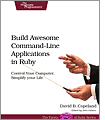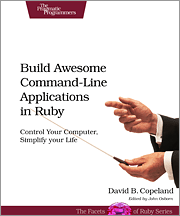Raleigh, NC—A GUI application isn't always the best solution: with its simple commands, flags, and parameters, a well-formed command-line application is the quickest way to automate a backup, a build, or a deployment and simplify your life.
In Build Awesome Command-Line Applications in Ruby (Pragmatic Bookshelf, $33.00) Ruby pro David Copeland explains how to write a command-line application that is self-documenting, robust, adaptable and forever useful. It's easier than you might think!
Ruby is particularly suited to this task, since it combines high-level abstractions with "close to the metal" system interaction wrapped up in a concise, readable syntax. Moreover, Ruby has the support of a rich ecosystem of open-source tools and libraries.
Ten insightful chapters each explain and demonstrate a command-line best practice. You'll see how to use these tools to elevate the lowliest automation script to a maintainable, polished application.
You'll learn how to use free, open source parsers to create user-friendly command-line interfaces as well as command suites. You'll see how to use defaults to keep options simple for everyday users, while giving advanced users options for more complex tasks.
There's no reason a command-line application should lack documentation, whether it's part of a help command or a man page; you'll find out when and how to use both. Your journey from command-line novice to pro ends with a look at valuable approaches to testing your apps, and includes some fun techniques for outside-the-box, colorful interfaces that will delight your users.
With Ruby, the command line is not dead. Long live the command line.
Available in epub, mobi, and PDF direct from the publisher and in paperback from fine bookstores worldwide.
What People are Saying
Some command-line applications save time and are a joy to use. Others just make you want to tear your hair out. David Copeland has written a guide to writing the kind of command-line apps that will make your users want to hug you.—Avdi Grimm, Ruby developer, author, and blogger, Virtuous Code I know of no other Ruby book that covers the content in this useful work, especially with its eye toward making Ruby command-line applications better citizens.
—Noel Rappin, Senior engineer at Groupon and author David brings an unmatched focus on user experience and testing. Every full-stack developer should learn how to build the kinds of apps covered in this book.
—Wynn Netherland, CTO Pure Charity
For a review copy or more information please email pragprogpr@oreilly.com. Please include your delivery address and contact information.
Additional Resources
For more information about the book, including:
video, code, errata, discussions, full table of contents, excerpts from the book and more, see the catalog page for Build Awesome Command-Line Applications in Ruby: Control Your Computer, Simplify Your Life.

|
Build Awesome Command-Line Applications in Ruby Publisher: Pragmatic Bookshelf By David B. Copeland Print ISBN: 9781934356913 Pages: 225 Print Price: $33.00 order@oreilly.com 1-800-998-9938 1-707-827-7000 |
About Pragmatic Bookshelf
Pragmatic Bookshelf is an imprint of the Pragmatic Programmers, LLC. Our titles are distributed to bookstores internationally by O'Reilly Media.
The Pragmatic Bookshelf features books written by developers for developers. The titles continue the well-known Pragmatic Programmer style, and continue to garner awards and rave reviews. As development gets more and more difficult, the Pragmatic Programmers will be there with more titles and products to help programmers stay on top of their game.
About O’Reilly
O’Reilly Media spreads the knowledge of innovators through its books, online services, magazines, and conferences. Since 1978, O’Reilly Media has been a chronicler and catalyst of cutting-edge development, homing in on the technology trends that really matter and spurring their adoption by amplifying “faint signals” from the alpha geeks who are creating the future. An active participant in the technology community, the company has a long history of advocacy, meme-making, and evangelism.
